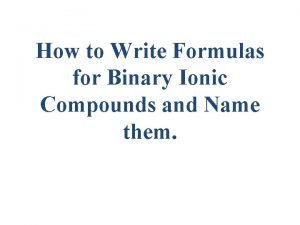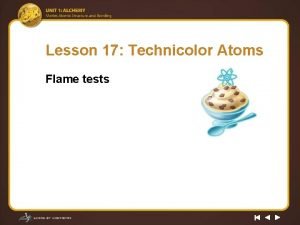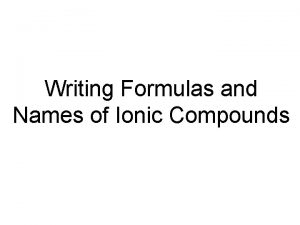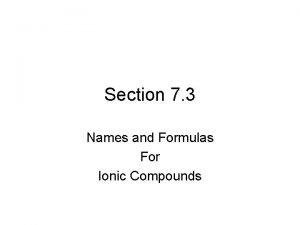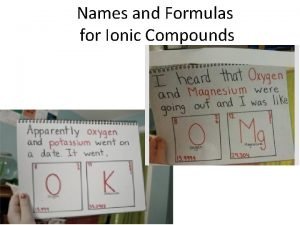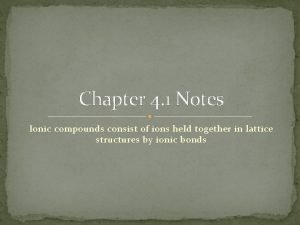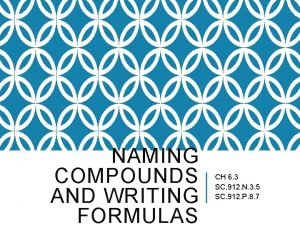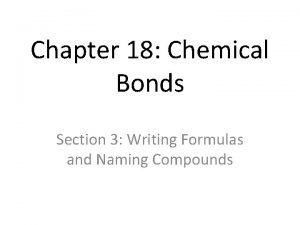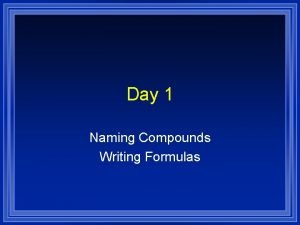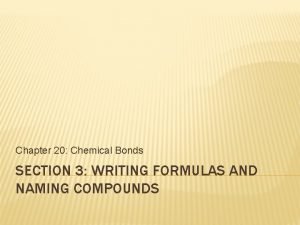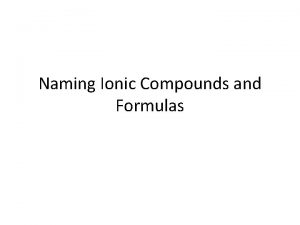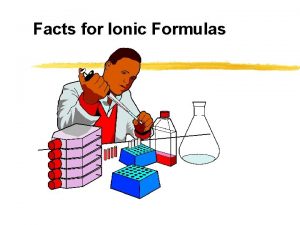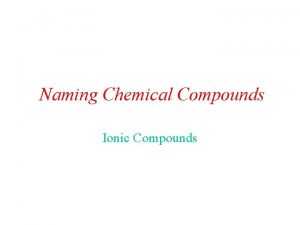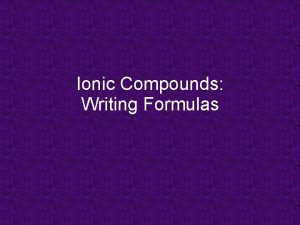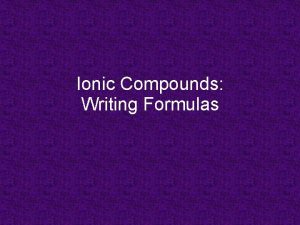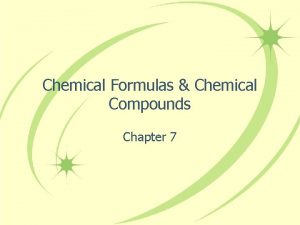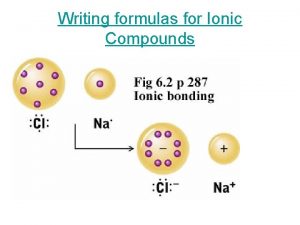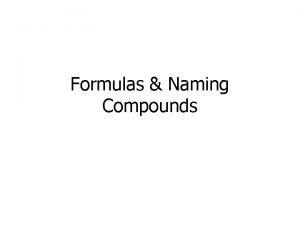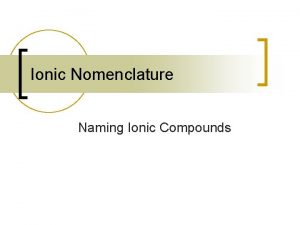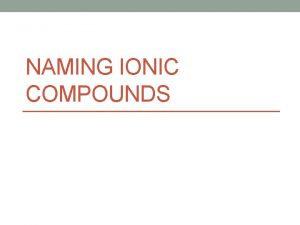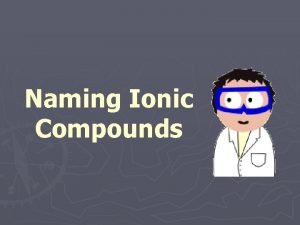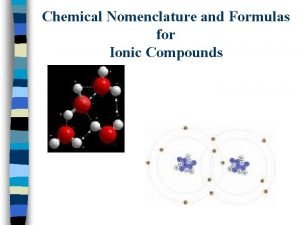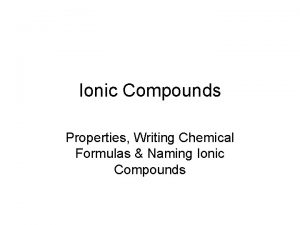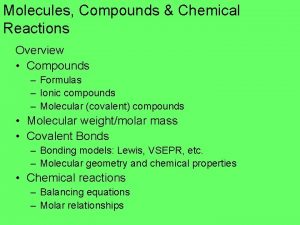Learning Chemical Formulas Simple Ionic Compounds Concept Ionic

















- Slides: 17

Learning Chemical Formulas

Simple Ionic Compounds Concept: Ionic Formulas are formed from positive and negative ions. Fact 1: Positive ions are formed by metals that lost electrons. Examples: Na 1+ Mg 2+ A 3+ P 4+

Simple Ionic Compounds z. Fact 2: Negative ions are formed by nonmetals that gained electrons. Examples: Cl 1 - O 2 N 3 - Si 4 -

Simple Ionic Compounds Fact 3: The overall charge of ionic compounds must equal zero. Examples : Na 1+ Cl 1 - Ca 2+Br 1 Al 3+O 2 -

Lesson Two--Polyatomic Ion Formulas Concept: Polyatomic ions are groups of atoms that behave as one unit. Fact 4: Some ions have more that one atom but their overall charge can be determined. Examples: (SO 4) = S +6 and O -8 = -2 (NO 3)= N +5 and O -6 = -1 (NH 4) = N -3 and H +4 = +1

Polyatomic Ion Formulas Fact 5: These group ions, polyatomic ions, are treated like single ions in formulas, but must have parentheses when more than one is used in a formula. Examples: Ca 2+(NO 3) 1 -2 Ga 3+ (SO 4) 2(NH 4) 1+2 O 2 -

Polyatomic Ion Formulas Fact 6: The polyatomic ions are named based on the atoms that they contain. Those with oxygen and another nonmetal are often name "____ate" with the root of the other nonmetal in the blank. Examples: (NO 3)1 - is nitrate (SO 4)2 - is sulfate (Cl. O 3) 1 - is chlorate

Polyatomic Ion Formulas Fact 7: Those polyatomic ions with one oxygen less than the "ate" ions are named "----ite" ions. Examples: (NO 2)1 - is nitrite (SO 3)2 - is sulfite (Cl. O 2)1 - is chlorite

Polyatomic Ion Formulas Fact 8: Some polyatomic ions contain a regular polyatomic ion and one or more hydrogen ions. Each hydrogen that is present add one positive charge to the total charge. Examples: (SO 4)2 -becomes H(SO 4)1(SO 3)2 - becomes H(SO 3)-1 (CO 3)2 - becomes H(CO 31(PO 4)3 - becomes H(PO 4)2 -

Polyatomic Ion Formulas Fact 9: These ion groups are named hydrogen ____ or bi ______. Examples: H(CO 3)1 - is called hydrogen carbonate or bicarbonate H(SO 4) 1 - is called hydrogen sulfate or bisulfate

Lesson Three--Transition Metal Compounds Concept: Transition metals have electrons in d orbitals and can donate different numbers of electrons, thus giving them several different positive charges. Fact 10: These can be determined from the Roman numeral which is written next to the metal's name. Example: Cu 1+is Copper I Pb 2+is Lead II Fe 3+is Iron III Sn 4+s Tin IV

Transition Metal Compounds Fact 11: These transition metals are used in formulas just like other metals, once the charge is determined from the Roman numeral in the name. Example: Cu 1+ Cl 1 Pb 2+O 2 Fe 3+Br 1 -3 Sn 4+O 2 -

Transition Metal Compounds Fact 12: A few transition metal ions only have one charge and never change so they can be written without a Roman numeral in their formula name. Example: Ag 1+ Zn 2+ Cd 2+

Lesson Four--Using Formulas in Problem Solving Concept: Correctly written chemical formulas hold a large amount of information for the prepared student to find. Fact 13: The subscripts tell us the number of atoms of each kind that is present in the compound. Example: Na. Cl has one atom of sodium and one atom of chlorine. H 2 SO 4 has two atoms of hydrogen, one atom of sulfur and four atoms of oxygen

Using Formulas in Problem Solving Fact 14: The sum of the atomic masses times the number of atoms of each kind of element is equal to the mass of one mole of the substance. Examples: Na = 23 g/mol and Cl = 35. 5 g/mol so Na. Cl has a molar mass of 58. 5 g/mol Nitric acid is HNO 3 so its molar mass is H=1 x 1 = 1 N = 14 x 1 = 14 O = 16 x 3 = 48 Total = 63 g/mol

Using Formulas in Problem Solving Fact 15: From the formula ion charges, also called oxidation numbers, can be determined using simple math processes. Example: Fe 2 O 3 is iron oxide, but what is the charge of the iron in this formula? It is known that the oxygen's ionic charge is -2 so substitute in that charge and find the iron's ionic charge. Fe--2 O-23 It is clear that the missing charge is +3. Thus the complete name of this compound is iron III oxide.

Using Formulas in Problem Solving Fact 16: The percentage composition of each element in a compound can be determined using only the correct formula and the atomic masses. Example: Sodium chloride or Na. Cl Na = 23. 0 % Na = 23. 0 x 100 = 39. 3%Na Cl = 35. 5 58. 5 g/mol % Cl = 35. 5 x 100 = 60. 7% Cl 58. 5 Notice that the total of the percentages is always equal or very close to 100%.
 Naming compounds
Naming compounds Empirical formula and molecular formula pogil
Empirical formula and molecular formula pogil Chemical formulas and chemical compounds chapter 7
Chemical formulas and chemical compounds chapter 7 Covalent and ionic bonds venn diagram
Covalent and ionic bonds venn diagram What is binary compound
What is binary compound Lesson 21 salty eights formulas for ionic compounds answers
Lesson 21 salty eights formulas for ionic compounds answers Charges of compounds
Charges of compounds Writing formulas for ionic compounds worksheet
Writing formulas for ionic compounds worksheet Section 3 names and formulas for ionic compounds
Section 3 names and formulas for ionic compounds Section 3 names and formulas for ionic compounds
Section 3 names and formulas for ionic compounds Criss cross chemistry
Criss cross chemistry Ionic bonding problems
Ionic bonding problems Concept 2 notes naming ionic compounds
Concept 2 notes naming ionic compounds Naming compounds and writing formulas
Naming compounds and writing formulas Ternary compound definition
Ternary compound definition Section 3 writing formulas and naming compounds
Section 3 writing formulas and naming compounds Tetraiodine nonaoxide formula
Tetraiodine nonaoxide formula Section 3 writing formulas and naming compounds
Section 3 writing formulas and naming compounds




